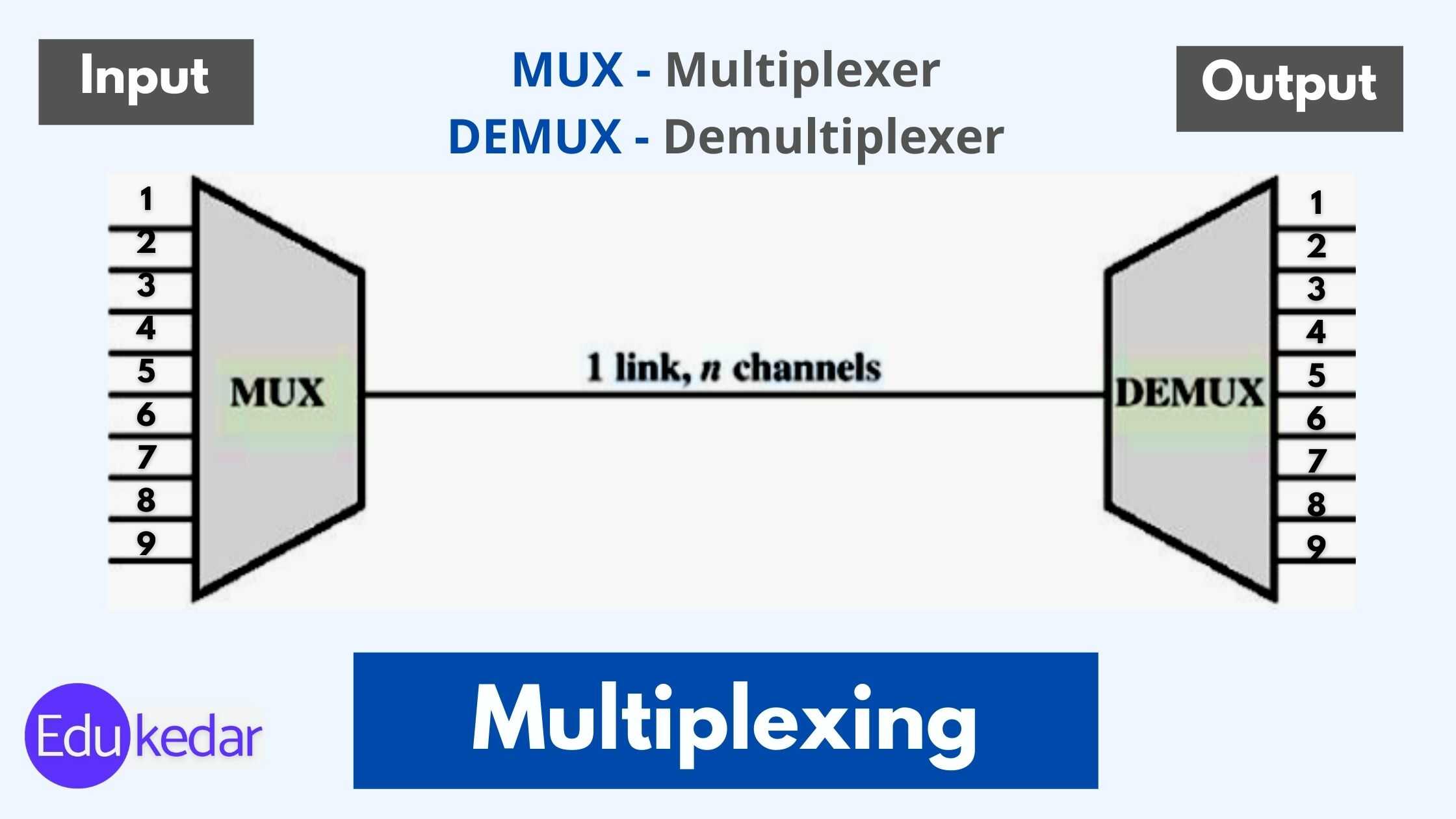We’ll go through the notion of multiplexing in computer networks in this tutorial. We have shared all the basic information about MUX used in networking. In this article, You will also learn the definition, importance, benefits, techniques, and different types of Multiplexing such as FDM, WDM, TDM, and their uses.
What is Multiplexing?
Multiplexing in Computer Networks is a term used to describe a collection of procedures that permits several signals to be sent over a single data link at the same time.
Multiplexing is accomplished with the help of a piece of hardware known as a multiplexer (MUX).
Meaning & Definition
Multiplexing is a process of sending the number of separate signals together over the same cable or bearer, simultaneously and without interference.
In Other Words,
Multiplexing is a technique where several users use the medium simultaneously without interference or with minimum interference.
What is Multiplexer and how it works?
A multiplexer (MUX) is a device that allows digital information from several sources to be routed onto a single line for transmission over that line (medium) to a common destination.
On the sender side, the Multiplexer (MUX) primarily mixes ‘n’ input lines in order to generate a ‘1’ output line (this is simply many-to-one).
This stream is routed into the demultiplexer (DEMUX) on the receiver side, which divides the stream into its component transmissions (one-to-many) and directs them to their associated lines.
The main objective of using the multiplexer technique is to share scarce resources.
Let’s look at how to partition one link into n channels using the diagram below:

The term link refers to the physical path in the figure above, while the term channel merely refers to the segment of the connection that conducts a transmission between two lines. As a result, a single link can have several channels.
History of Multiplexers
- Multiplexers in Computer Networking has a long and illustrious history.
- Several telephone calls can be carried over a single line in telecommunications.
- Multiplexers were also invented in the 1870s in telegraphy.
- This method is now frequently used in telecommunications.
- In telephony, George Owen Squier is credited with developing telephone carrier multiplexing in 1910.
Importance of Multiplexing
Multiplexing in data communication systems and Computer networks is very much required. As we previously stated, multiplexing is a set of techniques that permits the transmission of many signals at the same time through a signal data link.
When there is a requirement to send numerous signals from the sender side at the same time, a multiplexer is used to combine numerous signals into one so that we may receive them all at the same time on the receiving end.
Sending many signals in different ways is quite expensive, and it also necessitates the use of extra lines.
As a result, multiplexing is required. Consider a television cable distributor that distributes multiple channels over a single wire.
Must Read ➜ What is HTTP?
Advantages of Multiplexing
The following are some of the benefits and advantages of employing multiplexing:
- It allows for the transmission of numerous signals via a single medium or link.
- Multiplexing aids in the efficient exploitation of the medium’s bandwidth.
Techniques of Multiplexing (Types of Multiplexer)

Multiplexing is divided into two categories i.e. Analog and Digital.
There are mainly three types of techniques used in multiplexing. Let’s have a look at these various types of multiplexers:
- Frequency Division Multiplexing
- Wavelength-division Multiplexing
- Time-division Multiplexing
In the following sections, we’ll go through each of the above-mentioned techniques one by one.
1. Frequency-Division Multiplexing (FDM)
FDM or Frequency-Division Multiplexing is an analogy technology in which frequency technology is used
Signals with different frequencies are merged in a composite signal and then broadcast over the link using this technique. It is mostly used when the link’s bandwidth is greater than the total bandwidths of the signals to be delivered.
Each signal is of a distinct frequency in this case. To prevent the transmissions from overlapping, the channel is frequently divided by guard bands, which are strips of unused bandwidth.
In the case of frequency division multiplexing, if the input signal is digital, it must be converted to analogy before being used as the modulator’s input.
Frequency Division Multiplexing (FDM) is a type of frequency division multiplexing
The transmission line in FDM is separated into three segments, each of which represents a channel that carries one transmission, as shown in the diagram above.
Advantages of FDM
The following are some of the benefits and advantages of using FDM multiplexing:
- It is simple to send a huge number of signals at the same time.
- FDM multiplexing demodulation is simple.
- The transmitter and receiver do not need to be synchronized for proper functioning.
- When gradual narrowband fading occurs, just one channel is affected.
Disadvantages of FDM
There are a few disadvantages of using FDM, few of them are listed as follows;
- The bandwidth of communication lines must be quite large.
- When employing FDM, there is a problem called crosstalk.
- When wideband fading occurs, it affects all channels in the FDM.
- A vast number of filters and modulators are required.
Application of FDM
The following are the most common FDM applications:
- AM and FM radio broadcasting are one of the principal applications of FDM.
- The usage of FDM in television broadcasting is another use.
- First-generation cellular telephones also employ FDM.
Must Read ➜ What is Cyclic Redundancy Check (CRC)?
2. Wavelength-Division Multiplexing (WDM)
WDM or Wavelength-Division Multiplexing is an analogy technology based on the wavelength-division technique. This method is comparable to FDM.
Wavelength Division multiplexing allows distinct signals, such as optical or light signals, to be delivered across an optical Fiber. The high data rate capabilities of optical Fiber cable are leveraged using the WDM technology.
Various light waves from various sources are merged into a composite light signal, which is then delivered over the channel to the receiver using this approach.
With the help of a Demultiplexer, this composite light signal is split down into distinct light waves on the receiver side.
The use of prisms aids in the process of mixing and splitting light waves. This prism aids in the bending of a light beam based on its angle of incidence and frequency.
The Prism is the principal multiplexer in the WDM technology, and it combines the numerous optical signals to generate a composite signal, which is subsequently delivered through an optical fiber connection.
Advantages of WDM
The following are some of the benefits and advantages of using WDM multiplexing:
- Full-duplex transmission is feasible with the help of WDM.
- WDM is simple to set up.
- WDM allows several signals to be broadcast at the same time.
- This method is less expensive, and it is simple to expand the system.
- This method ensures a high level of security.
- Because optical fiber is used in WDM, optical components are more dependable and provide more bandwidth.
Disadvantages of WDM
There are a few disadvantages of utilizing WDM:
- Because optical equipment is used, the cost rises.
- Because bandwidth utilization might be wasteful, wavelength adjustment can be challenging.
- The biggest issue with this method is scalability.
Must Read ➜ Data Link Layer in OSI Model
3. Time-Division Multiplexing (TDM)
Time-Division Multiplexing (TDM) is a technique for combining many channels into a single channel. TDM is a digital multiplexing technique.
- The channel/link is separated by time rather than the frequency in this strategy.
- The total available time on the channel is shared among the many channel users.
- Each user on the channel is assigned a time slot/slice, which is a specific time interval.
- The data rate capacity in time-division multiplexing should be significantly higher than the data rate required by the transmitting and receiving devices.
Types of TDM-multiplexing
TDM multiplexing is further divided into two types:
(i) Synchronized TDM
(ii) Asynchronous TDM
(i) Synchronous Time-Divison Multiplexing (STDM)
Even though the input link is not providing data, it has an allocation in the output in Synchronous TDM.
Each device is allocated the same time slot to transmit data over the link, regardless of whether it needs to send data to the receiver.
Each device sends data to the link when its time slot comes, so control is passed from one device to the next.
In the event that any devices do not have any data to communicate, the time slot for that device remains unfilled.
There are ‘n’ sending devices, then there will be ‘n’ time slots available at the same time, which means a one-time slot for each device.
Time slots are also grouped into frames, with each frame including one or more time slots.
Advantages of Synchronous (STDM)
- This approach is simple to use.
- Using this strategy, you may be sure of a good result.
Disadvantages of Synchronous (STDM)
- If a user does not have any data to transmit, time slots will be squandered.
- The transmission link’s capacity must always be greater than the total capacity of the input lines in this multiplexing.
(ii) Asynchronous Time-Division (StatMUX)
Asynchronous is another type of TDM, time-division multiplexing.
Asynchronous TDM is also known as Statical Time Division Multiplexing. Now let’s have a look at the advantages and disadvantages of Asynchronous TDM
Advantages of StatMUX
- Time slots are not set in this case; instead, time slots are allocated dynamically to increase bandwidth efficiency.
- The combined speed of all input lines may be more than the path’s capacity.
- There are n input lines and m slots in this Multiplexing, hence it is always a (mere) efficient use of transmission capacity.
Disadvantages of StatMUX
- Frames of various sizes are used in this Multiplexing.
- Because there are no different slots given to each user, the buffer address information is also required.
- This method does not guarantee a specific waiting time.





